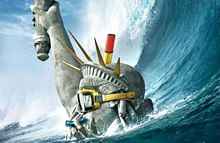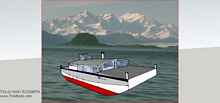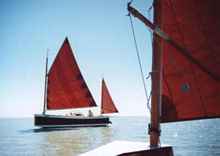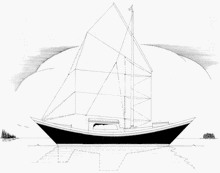
| sails |
| plans |
| epoxy |
| rope/line |
| hardware |
| canoe/Kayak |
| sailmaking |
| materials |
| models |
| media |
| tools |
| gear |
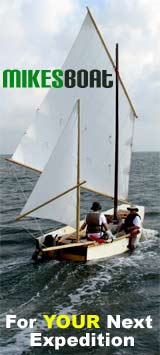 |
 |
| join |
| home |
| indexes |
| classifieds |
| calendar |
| archives |
| about |
| links |
| Join Duckworks Get free newsletter Comment on articles CLICK HERE |
|
|
| Guest Column |
by Dave Zeiger - Sitka, Alaska - USA TEOTWAKI x (MAIB + KISS) = BOB |
TEOTWAKI x (MAIB + KISS) = BOB: TEOTWAWKI = The End Of The World As We Know It When in danger, when in doubt, Okay. I’ll be the first to self-identify as a bona fide member of the Lunatic Fringe. But it’s not so lonely out here, any more. The queasy feeling is spreading that TEOTWAWKI is coming. Maybe soon. Market collapses, trouble in EuroZone, sovereign default, liquidity crises, credit still stand... these are now headline issues of the Fortune 500. TEOTWAWKI has happened many times. Babylon and Rome are fallen. New World civilizations collapsed catastrophically in the face of Old World diseases. Katrina. Fukushima. Afghanistan. People around the world are undergoing the end of their worlds as I write. It’s happening now. In our global, supply-on demand, trade and oil dependent economy built on the seamless flow of electronic representations of paper... And really, how much does it take to affect you, personally? What does it take to trip that AWKI bit? May lose - or have lost - your job? Your house? Health? Savings? Pension? Social Security and Medicare - insurances you’ve been paying for all your working life - these are looking shaky. We don’t need to be speaking of apocalyptic events... dramatic change in ‘business as usual’ does it. Still with me? Okay. MAIB. It’s why we’re here; what we do. But let’s look at this in the context of TEOTWAWKI. Dmitry Orlov wrote a great essay on the subject, The New Age of Sail. Bug Out \Bags are the bag you reach for on your way out the door... just before the roof caves in. The maritime equivalent is the ‘abandon ship’ or ‘Hail Mary’ bag. BOBs are advocated by disaster preparedness groups (such cultish, doomsaying nut-cases as USCG, TSA, FEMA and your local SAR). Well supplied, it will help get you and yours through a stretch o’ hard times. How about a Bug Out Boat?? For considerably less than our primitive ancestors spent on cold war bomb shelters, we can outfit ourselves with something that’s both a joy to use while the sun shines, and may save our butts one dark day. Look at what a sailboat represents: Mobile shelter; unlimited range. You can carry crew, supplies, gear and tools and trade for extended periods. If things stay bad, a boat can support a permanent shift to a new way of life; the life you’ve been dreaming of, anyway. You can get yourself to forage and fishing grounds to feed yourself. Guerrilla gardens ashore. Let’s put up a wish list for a bug out boat:
Not asking much, are we? Here’s a couple more things to consider:
Build or Buy? Certainly buying has advantages. You plop down sufficient cash and there it is. Often this comes to less up front than building. But it’s hard to find boats that meet the criteria for a bug out boat without modification. By the time you tot up all the nickles and dimes necessary to get her the way you want, you might have done better to build. Even in a buyer’s market, good cheap boats are few and far between. Still, it will depend on supply and demand. You could get lucky. So let’s say we’re going to build. The sky could fall any day now, so we don’t want to spend years at this. Things are tight already, so we don’t want to bust the bank, either. Besides, we haven’t done much more than build the kids a tree-house... let’s Keep It Simple, Sailor. While we’re at it, let’s try to get the most bang for our buck. I propose this list of KISS attributes:
It is the combined economies of these points that keep overall costs down. I can’t see that expensive complexity has any place on a KISS vessel. Double ditto for a BOB. These principles together that up your Got ‘er did factor. They also up your bang for the buck. To these, I would add my own KISS advice, accumulated over 20 years of Chicken Littling about far from the chandlery:
When the fewmets start to percipitate, it’s too late. The clock is ticking now, and history - global (possibly) and individually (without a doubt) - is fleeting toward change. Even if it’s only by the advance of years, our own, personal TEOTWAWKI approaches. Go small, go simple go now! Please visit our site at www.TRILOBOATSHYPERLINK "https://www.triloboats.com/".com, and blog at triloboats.blogspot.com.
Anke and I live aboard SLACKTIDE, our T26x7 ketch. We sail by wind, tide and muscle in the waters of Southeast Alaska. We try to maximize the joys of life, and minimize the chores. We live between communities, but drop in to visit with friends. We're working toward a subsistence lifestyle, somewhat impeded by addictions to coffee, chocolate and cheese. We think TEOTWAWKI is looming, and while we’ll never be ready, we'd at least like comfortable seats. (Scroll down for bonus section of sample BOBs) Here are three families of full-cruiser, BOB candidates, well within reach of the average Dick and Jane and presented in order of difficulty. Each have plans available in a range of sizes. More complex boats are possible, of course, but these provide a baseline for consideration:
TriloBoat Barges - www.TriloBoats.com - Ultra Shoal - Sizes 16ft to 40ft (potentially higher) These are my contribution, optimized for easy, quick and inexpensive construction. Right angles, minimal curves, and whole and half sheets are emphasized throughout, holding lofting, layout, cutting and spiling to a minimum. Sheet materials impose the shape trueing and squaring are automatic. Easy to insulate with foamboard in composite panels, constructed flat prior to assembly. Boats don’t come any easier to build. Barges maximize displacement and interior volume, meaning you can carry a lot for their size, with lots of room to put it. The basic hull supports a huge range of layouts without blinking, making them extremely adaptable by persons armed with little more than common sense. TriloBoats may be rigged for sail, and have proven themselves in Alaskan coastal waters. Sailing box barges can be found on most coasts of the world, and date back millenia.
Bolger ADVANCED SHARPIES - Phil Bolger & Friends, Inc. - Ultra-shoal - Sized 16ft to 54ft (AS Series) PO Box 1209, Gloucester, MA 01930 USA AS hulls have curvature in plan and profile view, but no flare. Rectangular sections ease construction by eliminating bevels along the chines. Jigless construction. Interiors vary, but may be reworked for simplicity where considered necessary. They’re fast, fine sailors well proven in extended ocean passages and cruising. AS shaped sides (vs. full sheet construction in TriloBoats and Silver Gulls) add building time. Side curvature (vs. parallel sides in TriloBoats) complicate fitting the interior. While you’re on Bolger, check out BIRD- and WHALEWATCHERs and Bruce Hallman’s 3D renditions of the many other Bolger candidates, many less radical than these mentioned.
McNaughton SILVER GULL Series - www.MacNaughtonGroup.com - Sized 19ft to 40ft These dories are curvy double-enders with flared sides. Parallel side panel edges ease construction and reduce waste by emphasizing whole sheet construction. Their flare imposes sheer and bottom rocker, with constant (vs. rolling) bevel along the chines (not an issue in tape ‘n’ glue construction). Silver Gulls won’t carry as much for their length as preceding designs, but are good sea boats, sharing many qualities with the famed St. Pierre dories. Their high ends make great, sea-riding shapes. The designers have fitted twin keels to at least one in the series, so these can take the beach upright, with less draft than a deep keel. SGs have a simpler hull proper, compared to AS hulls, but their keels complicate construction and add draft. Flared sides (vs. right angle sections) require beveled chine logs and complicate fitting the interior. Other KISS BOB Contenders: Macro-BOBs: Parker EGRET Series, Scows, Sharpies Micro-BOBs: Bolger Designs (Lots of web presence, order plans from address listed above). My apologies to the hundreds of great designers and designs omitted here. To get a feel for the range of possibilities, go to Google Images (link along the top of any Google search page) and search for, say, “sharpie sailboat”. Follow your head and heart. Try not to be up all night! END NOTE: Shoal boats with high freeboard are often derided as unseaworthy, directly in the face of hands-on witness to the contrary. In fact, such hulls have some distinct advantages, having nothing to trip them up in a broach. A shallow hull tends not to disturb a wave into breaking. High freeboard provides enormous reserve buoyancy. These factors all reduce risk of broach, roll-over, pitch-pole and getting pooped. Their light weight (low inertia) reduces the impact force from broad-on waves, reducing risk of gear and structural damage/failure. Windage is similar to deeper boats of similar size, having cabin and other deck structures. Free standing rigs and leeboards meet similar prejudice. Yet they’ve been going to sea - and coming back - from time out of mind. Boats and their components are neither immune to the sea, nor do they sail themselves. Every boat trades one set of virtues for another. Most have a vice or several associated with those virtues. If this were not so, there would be one single type that met all needs. Assess your needs, look around at tried and true solutions, take calculated risks with sensible innovations. If your ‘ideal boat’ is out of reach, open your mind. Don’t let ideals keep you off the water! It is the sailor’s task to make his boat sail. |
